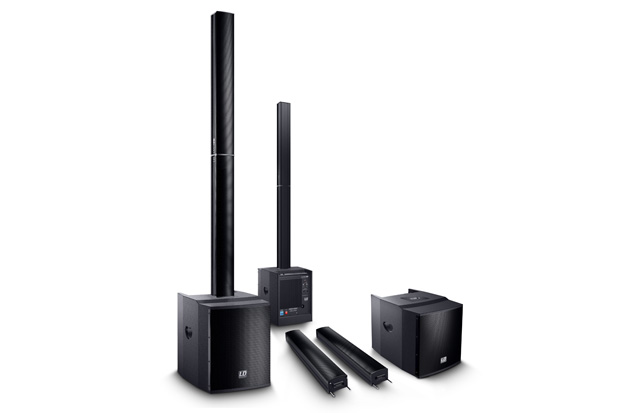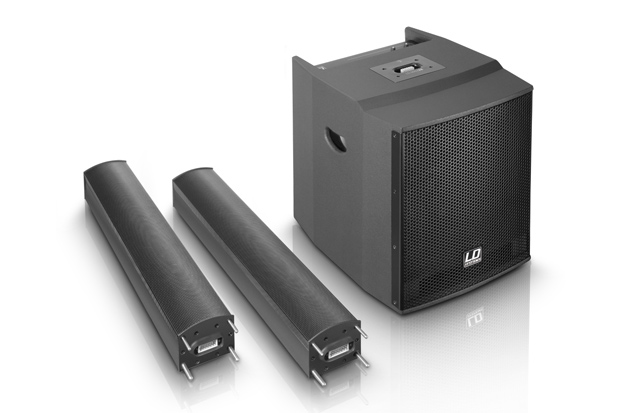LD Systems “MAUI” compact PA, practical Test: Part 1 – Test Report by tools4music
For a band like “bassa” (see tools 4 music, issues 6/2009 and 11/2010), which is on the road a lot and plays concerts in a very wide range of venues, it is especially important to be able to use a sound reinforcement system that is flexible and as unobtrusive as possible. Experience has shown that it is often impossible to attain self-imposed standards of quality with the equipment available onsite. Thus there are only two possibilities: accept the inevitable or go to the trouble and expense of always taking along a complete sound reinforcement system including FoH and monitoring. We chose the latter option.

It takes more than just creativity for a band to live up to constantly increasing audience expectations and, of course, its own standards. The equipment must also meet a high standard of quality. For our fall tour of Germany, the distributor Adam Hall kindly provided us with a “MAUl 28” (Multiple Array User Intuitive) system from LD Systems and an LD MEI-1000 in-ear monitoring system for our five-piece band.
Right on schedule, one week before our tour kicked off at the Jazzclub in Erfurt, a haulage firm delivered the equipment (including caster boards and form-fitting protective covers) on half of an Euro pallet. I was immediately happy about the pleasant handling. The subwoofers – which are made of multiplex – weigh 29 kg and have two well balanced, recessed handles in the cabinet, so they are still easy to transport. The caster boards are quickly at hand for longer distances. The subwoofer has a front-mounted, “V”-shaped 2 x 8″ speaker configuration. The columns (or Vertical Array Modules, as LD Systems calls them) have 16 x 3″ speakers per side and are each equipped with a 1″ tweeter and stored in a padded carrying case. Weighing in at 8 kg, they are flyweights in comparison with a conventional 12″ cabinet.
Handling
Both systems were fully assembled and ready to go within ten minutes. Every minute counts when you have to set up and take down a system like this every day for two weeks, especially without the benefit of roadies.
The mount for the lower array module, which is held securely by four steel pins and a multipin connector, is on the top of the subwoofer. The second array module is plugged on using the same mechanism. Operation and connection of the active system are self-explanatory. The power amp module for the sub and the arrays is on the rear of the bass module. Five LEDs on the top of the power amplifier module (On, Lock, Signal, Limit and Protect) provide information about the operational status, whereby the Lock LED indicates that the modules are mated properly. The protective circuit does not switch the signal on electrically until the LED lights up. Additionally, there are two potentiometers with detents for main and sub level. The audiences at our concerts usually pay close attention (with little background noise), so it is especially positive that the cooling system makes do without any active fans. We noticed that while the large cooling fins are recessed in the rear of the cabinet, they are still pretty sharp at the top edge. Perhaps a better solution will be found in the next version of the MAUI. The rear panel holds the stereo signal inputs, which take the form of Neutrik combo sockets with locks. There are also XLR link output sockets for passing the signal to an additional system, as well as a pair of RCA connectors. Last, but not least, there is the lockable power connector and the large, illuminated power switch.

Live in Erfurt
The Jazzclub Erfurt is located in an old vaulted cellar in the middle of Erfurt’s old town centre and problematic acoustics are not the only thing that sets it apart. The extremely low ceiling clearance at the side edge of the stage also makes it difficult to set up the more than two-metre high “MAUI” system there. For this reason, we assembled one system at the rear edge of the stage right behind our guitarist. The broad, 120-degree dispersion pattern eliminated any need for onstage monitoring. Simultaneously, this resulted in sound reinforcement that still sounded good to the audience. For our taste, the system has a very well balanced sound. There does seem to a slight overemphasis on the midrange right in front of the system. This impression is relative, however. At a distance of 1.5 to 2 metres, the tweeter blends very harmoniously into the overall acoustic picture. With its 2 x 8″ configuration, the subwoofer is just the right size for our application (this has less to do with beefy 24″ bass drums and loud Marshall stacks – the editor) and can be adapted to the surroundings with the sub level control if necessary. The “MAUl” seems like a sound reinforcement solution that was designed especially for us. I was able to deactivate the master EQ on our Yamaha digital console and astoundingly, especially considering the problematic acoustics, immediately had a natural and balanced sound. Audience members confirmed this to me during the intermission.
Live in Stuttgart
The next day, our travels took us to Tango Ocho, a tango school in the artists’ enclave Wagenhallen in Stuttgart. The room acoustics: a large dance floor with relatively smooth, acoustically reflective walls and high susceptibility to feedback. The 8×3 metre (WxD) stage called for a classic stereo placement of both systems. In this situation, too, the fast and straightforward setup was a joy. During the sound check: not a trace of feedback trouble, although we used an AKG C-414 large diaphragm microphone onstage for the clarinet and the volume level of the back line was appreciably loud. That is necessary when “bassa” is booked to play for tango dance parties – where the dancing alone is enough to boost the level of background noise considerably. “MAUl” mastered the task very well – the sound was clear and the instruments were distinctly placeable from anywhere throughout the room. The large range of the system is a clear advantage in comparison with conventional systems. Compared to the Bose Ll.II, which we have also already used, the bass carries much further. Even at extended distances, there is hardly any drop-off in the bass frequencies, which meant that I was able to dial back the bass to 3/4. At this event, too, the feedback from the audience and the promoter with regard to the band and the PA was positive for all concerned.
A look ahead
The second part of this practical test will cover some unusual venues, from a hair salon to a market hall. We are curious to see how the “MAUI” system does there.
Manufacturer response
Viktor Wiesner, Product Manager, Adam Hall: “The edge design of the cooling element is already being improved in the current production run. We are looking forward to part two of the practical report.”
Facts:
Manufacturer: LD Systems
Model: LD “MAUI 28″
Type: Subwoofer and vertical array
Vertical array system (2 units): 16 x 3”
HF: 1-inch horn tweeter
Amplification: Class A/B
Dispersion: horizontal 120° (average value)
Power output (W/RMS):
Subwoofer: 200 W;
Array system (W/RMS): 200 W
Frequency response: 45 Hz -20 kHz
Sensitivity (1 W/1 m): 98 dB
Max SPL: 115 dB
Protection: limiter
Controls: Volume, sub level, on/off switch
Indicators: On , Lock, Signal, Limit, Protect
Subwoofer connectors:
Input: RCA/XLR/ 6.3 mm jack (combo)
Array connectors: Multipin connector
Subwoofer cabinet material: 15mm MDF
Satellite cabinet material: Aluminium
Surface protection: HD coating
Dimensions (W x H x D):
Subwoofer: 390 x 450 x 510 mm;
Satellite: 110 x 790 x 90 mm
Weight:
Subwoofer: 29 kg
Satellite: 3.6 kg
For additional product information, go to:
http://ld-systems.com/356-1-ld-maui28-black.html
Source: tools4music, Germany
Leave a Comment
You must be logged in to post a comment.












